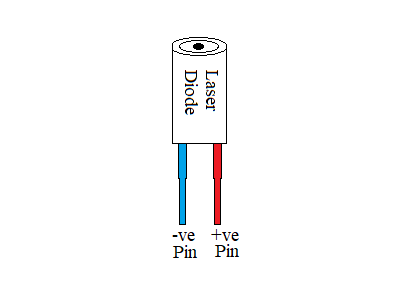2.jpg)

2.jpg&width=175&quality=80)

2.jpg&width=300&quality=80)

650nm 6mm 5V DC 5mW Mini Laser Dot Diode Module
A laser diode (LD) is a type of diode that emits coherent light when current flows through it. It is a semiconductor device similar to an LED (Light Emitting Diode), but it produces a narrow, focused, and coherent beam of light (laser), typically in the infrared or visible spectrum, depending on the materials used in its construction.
₹ 26 ₹49
49
Add FAQ
A laser diode (LD) is a semiconductor device that emits coherent light (laser) when an electrical current is passed through it. Similar to regular diodes, laser diodes operate based on the principle of electroluminescence, but the light they emit is coherent and focused, unlike the broad-spectrum light emitted by LEDs.
Key Features of a Laser Diode:
-
Coherent Light: Unlike regular LEDs, which emit light in a broad spectrum, a laser diode emits monochromatic (single wavelength) and coherent light (light waves are in phase and travel in a single direction).
-
Wavelength: Laser diodes come in a wide range of wavelengths, usually from the infrared (IR) spectrum (800 nm to 1500 nm) to the visible light spectrum (400 nm to 700 nm). The most common laser diode wavelengths are:
- Red (around 650 nm)
- Green (around 520 nm)
- Blue (around 450 nm)
- Infrared (IR) (around 850 nm, 980 nm, etc.)
-
Forward Voltage: Laser diodes typically require a forward voltage in the range of 1.5V to 2.5V, depending on the type of laser diode.
-
Power Output: The output power of a laser diode can vary from low-power diodes used in applications like pointers (around 1–5 mW) to high-power diodes used in industrial or medical applications (up to several watts).
-
Beam Divergence: Laser diodes typically emit a beam with low divergence, meaning the light stays tightly focused over long distances. This makes them ideal for applications where precision is required.
-
Polarized Light: The light emitted from a laser diode is usually polarized, meaning the light waves oscillate in a particular direction.
How a Laser Diode Works:
-
Electron-Hole Recombination: When a current flows through the laser diode, electrons in the negative side of the diode combine with holes in the positive side. As the electron recombines with a hole, it releases energy in the form of photons (light).
-
Stimulated Emission: The photons created in the active region of the diode stimulate other excited atoms to emit more photons of the same wavelength and phase. This process leads to the amplification of light.
-
Optical Cavity: The light produced in the diode bounces between two mirrors placed at either end of the diode. One of the mirrors is partially transparent, allowing a small portion of the light to escape. This is the laser beam.
Applications of Laser Diodes:
-
Laser Pointers: The most common consumer application, laser pointers use low-power red laser diodes (around 650 nm) to create small, focused beams of light for presentations or marking objects.
-
Fiber Optic Communication: Laser diodes are used in fiber optic communication systems because of their ability to produce a narrow, high-intensity light that can be transmitted through optical fibers with minimal loss.
-
Optical Storage Devices: In devices like CD, DVD, and Blu-ray players, laser diodes are used to read and write data on optical discs by focusing a laser beam onto the surface.
-
Barcode Scanners: Laser diodes are commonly used in barcode scanners, where their focused light scans and reads the barcodes by reflecting off the black-and-white patterns.
-
Medical Lasers: Laser diodes are used in medical applications such as laser eye surgery, dental procedures, and laser therapy due to their precision and focused energy.
-
LIDAR (Light Detection and Ranging): Laser diodes are used in LIDAR systems, which are employed in autonomous vehicles, mapping, and environmental sensing.
-
Laser Printers: In laser printers, a laser diode is used to form the image on a drum that will later be transferred to paper.
-
Laser Welding/Cutting: High-power laser diodes are used in industrial applications like cutting and welding materials due to their high energy and precision.
-
Sensor Technology: Laser diodes are also used in various sensor technologies, such as proximity sensors, level sensors, and distance measuring sensors.
Safety Considerations:
-
Eye Protection: Laser diodes, especially those with high power (such as infrared lasers), can be harmful to the eyes. It is important to avoid direct exposure to the laser beam. Always use proper protective eyewear when working with powerful laser diodes.
-
Laser Classification: Laser diodes are classified based on their power output and potential hazards. For example:
- Class I: Safe under all conditions.
- Class II: Low power lasers, typically below 1 mW (like laser pointers).
- Class IIIa: Lasers that may be hazardous if viewed directly but are typically less than 5 mW.
- Class IV: High-power lasers that can cause permanent damage to eyes or skin.
Example Circuit:
In a typical circuit, a laser diode might be powered by a constant current driver because laser diodes require precise current control to operate efficiently and safely. The circuit would consist of the following:
- Laser Diode: Emits the laser beam.
- Current Limiting Resistor: Helps regulate the current to prevent the diode from burning out.
- Power Supply: Usually a DC voltage source that is appropriately regulated to provide stable current to the laser diode.
For example, in an Arduino project:
- A laser diode (e.g., 650 nm red) could be connected to a current-limiting resistor and driven by an Arduino pin with a transistor or a constant current driver to power it.
Conclusion:
Laser diodes are versatile and widely used in both consumer electronics and industrial applications due to their precise and focused light emission. They are essential components in many modern technologies such as communication, sensing, printing, medical devices, and more.

0 Reviews For this Product












2.jpeg&width=225&quality=80)
2.jpeg&width=225&quality=80)
.jpeg&width=225&quality=80)

